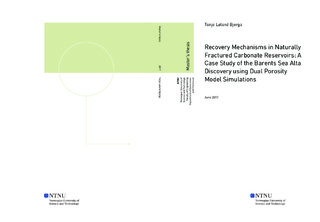| dc.description.abstract | The Barents Sea Alta discovery consists primarily of fractured carbonate formations from the Mid-Carboniferous to Permian period. Significantly fractured reservoirs are subject to different recovery mechanisms than conventional ones including gravity drainage, spontaneous imbibition, fluid expansion and diffusion. The reservoirs are commonly analyzed as two porous systems and the main objective lies in optimized oil transfer from the tight matrix to the fracture. This process depends on characteristics of the reservoir that typically have great uncertainty, making fractured reservoir development one of the most difficult technologies in oil field exploitation.
This thesis investigates oil recovery from the Alta dual porosity system with respect to key reservoir parameters; matrix block height, size / shape, capillary pressure, wettability and inter-block contact. Wettability is essential for recovery in fractured reservoirs, and as 80 % of the world s carbonate reservoirs have shown oil-wetting tendencies, this poses an important subject in the Alta field concept studies (Treiber et al., 1972; Chilingar and Yen, 1983). The impact of the listed reservoir characteristics are tested with crestal gas injection as well as water injection in the underlying aquifer. The study is performed using ECLIPSE s dual porosity/ dual permeability model of which computational aspects and validity is discussed.
Typical gas-oil capillary pressure curves for vuggy carbonates are tested with varying vertical matrix block height. The results show that block height is essential to achieve good recovery when matrix blocks are completely discontinuous. However, matrix-matrix flow corresponding to only 5 % contact area between the blocks, gives a dramatic increase in recovery. If the contact area exceeds 25 %, recovery is close to that of a completely continuous stack, while production of water from the aquifer remains lower. When the reservoir rock is strongly oil-wet, poor recovery is achieved with water injection, as entry of water into the matrix becomes a drainage process. If the reservoir is strongly water-wet, full recovery is achieved with spontaneous imbibition, and matrix block height is insignificant for the entry of water into the matrix. The examples also show that with tall matrix blocks, movement of the water front in fractures close to the producer is accelerated, which may reduce ultimate
recovery due to an early water-breakthrough. The sigma factor is tested and found to have larger effect in an imbibition process compared to gravity drainage, which is important to consider in history matching of well data.
The thesis concludes that as long as either matrix shape, matrix height or reservoir
wettability represent a great uncertainty in the Alta discovery, gas injection is the safest choice. However, lack of infrastructure in the Barents Sea combined with less availability of gas compared to water, is acknowledged and potential concepts briefly discussed. A simplified WAG injection example is also included and shows increased recovery compared to one phase water injection. All findings of this thesis form a solid foundation for more detailed studies of a WAG strategy in the Alta discovery. | en |

